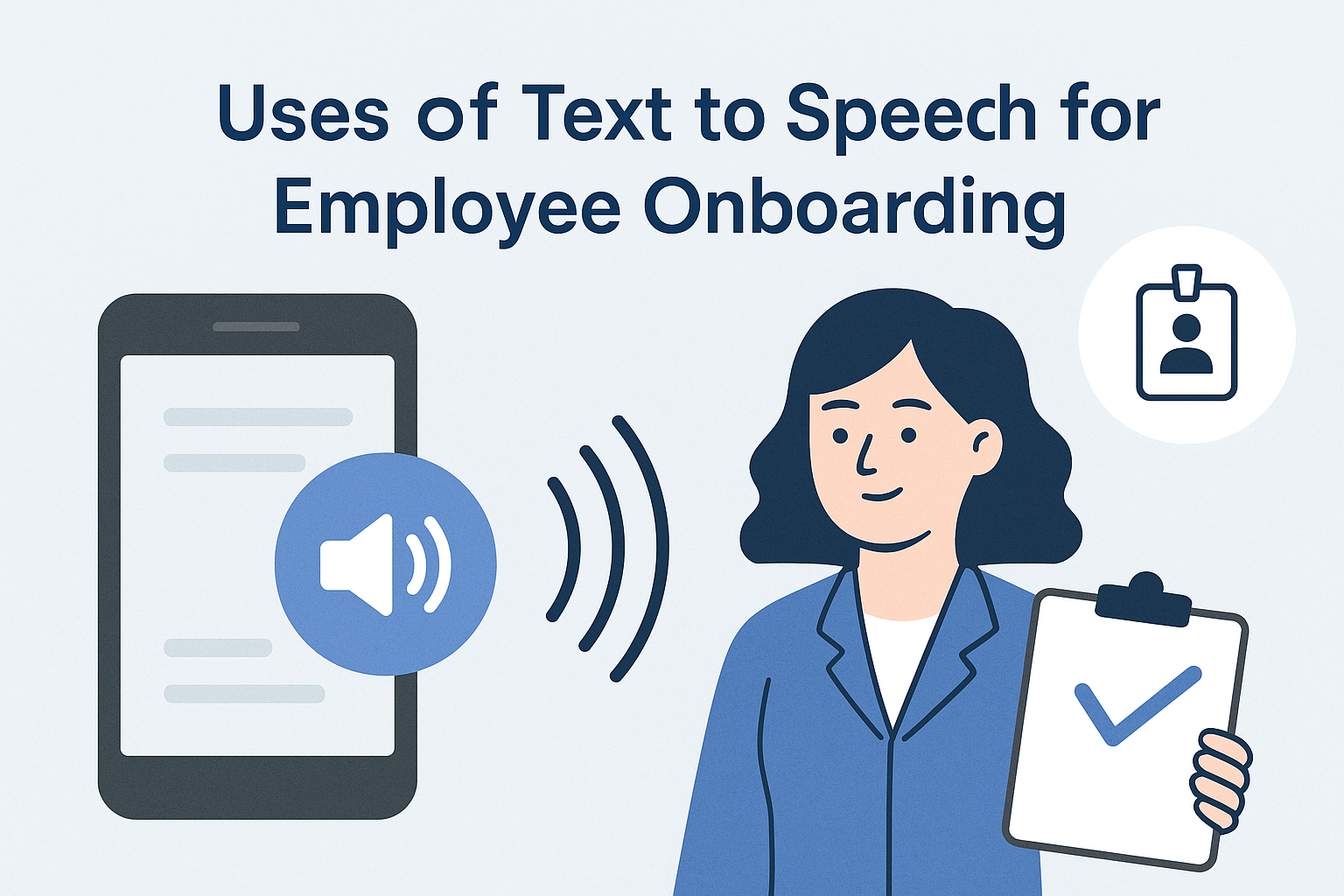Text-to-Speech (TTS) technology converts written content into clear, natural-sounding audio, making information more accessible and engaging. Effective employee onboarding plays a crucial role in helping new hires understand company culture, processes, and expectations quickly.
By integrating TTS into onboarding programs, organizations can deliver consistent, interactive, and easily digestible training materials. This approach ensures that employees absorb key information efficiently, feel welcomed, and stay motivated from day one, while simplifying the onboarding workflow for HR teams and creating a modern, learner-friendly experience.
Role of TTS in Employee Onboarding
Text-to-Speech (TTS) plays an important role in employee onboarding by turning written training materials into spoken content that new hires can easily understand. It helps companies deliver consistent training messages across departments, ensuring every employee receives the same guidance and tone.
TTS improves accessibility by supporting employees with visual impairments or reading difficulties, making training more inclusive. Furthermore, it increases engagement by converting static text into natural audio, helping learners retain information better.
Since people learn differently, TTS supports diverse learning styles, whether auditory, visual, or kinesthetic, creating a smoother and more personalized onboarding experience for every new team member.
Key Uses of TTS in Onboarding
- Delivers consistent company introductions and policy explanations.
- Simplifies complex HR information with clear voice narration.
- Enhances accessibility for visually impaired or multilingual employees.
- Provides 24/7 self-paced learning through voice-guided modules.
- Increases engagement using natural, conversational voices.
- Reduces trainer workload with automated voice-based orientation.
- Ensures uniform communication across global onboarding programs.
Strategies to Implement TTS Effectively
Implementing Text-to-Speech (TTS) effectively begins with seamless integration into HR platforms and Learning Management Systems (LMS) to make training and onboarding smoother. It allows employees to listen to policies, guides, and training modules anytime, supporting flexible learning.
Personalizing TTS with various voice options, accents, and playback speeds helps create a more relatable experience for diverse teams. Additionally, combining TTS with interactive tools such as quizzes, assessments, and visual elements enhances engagement and retention.
When learners can listen, respond, and interact at their own pace, the entire process becomes more inclusive, efficient, and enjoyable for everyone in the organization.
Overcoming Challenges and Maximizing Effectiveness
Overcoming Challenges and Maximizing Effectiveness begins with ensuring every voice is heard clearly. When using Text-to-Speech (TTS), maintaining crisp audio clarity and balanced voice quality builds listener trust.
A mix of TTS narration with human-led guidance makes the experience feel natural and engaging. Monitoring audience engagement helps track how well the message connects, while feedback reveals what works best. Choosing a reliable TTS platform like Speechactors ensures lifelike tone, pronunciation accuracy, and emotional expression.
By blending high-quality voices, clear sound, and audience insights, creators can deliver content that feels personal, smooth, and truly effective for every listener.
Why Choose Speechactors for Employee Onboarding

Speechactors offers a rich AI-driven text-to-speech platform with over 300 natural voices across 140 languages, emotion control, pitch/rate adjustment, multi-voice support, background music, and custom pronunciation.
For HR teams, it streamlines voice narration of training modules, policy explainers, and orientation scripts, freeing HR from voice recording tasks. Employees receive consistent, engaging audio content that enhances retention.
In practice, companies have embedded Speechactors’ voiceovers into onboarding LMS modules and internal training videos, accelerating assimilation and improving clarity. Many organizations report smoother employee induction using AI voice technology.
Future Trends: TTS in Corporate Training
TTS in corporate training is moving toward natural, multilingual, and scalable voice learning.
Neural models now shape lifelike narration with clear prosody, pauses, and emotion. Voice cloning and speaker adaptation keep brand tone consistent.
SSML controls let teams fine-tune pitch, pace, and emphasis. Real-time synthesis helps microlearning, safety drills, and software walk-throughs feel engaging. Multilingual voices support local accents for global teams.
Adoption trends point to wider use across LMS and authoring tools, faster content updates without studio time, and stronger accessibility compliance. Global rollouts benefit from instant localization, consistent QA, and measurable learning analytics when TTS ties into xAPI or SCORM. Picture modules that speak naturally, fit every region, and keep training fresh at scale.
Frequently Asked Questions (FAQs)
How can TTS improve onboarding effectiveness?
TTS improves onboarding by delivering clear, consistent voice content. Studies show employees retain up to 60% more information when learning combines audio with text. It speeds understanding and engagement.
Is TTS suitable for all types of training materials?
TTS works well for documents, presentations, and e-learning modules. Research shows audio narration boosts comprehension for visual and reading-based content, making learning easier and more interactive.
Can Speechactors support multilingual onboarding?
Yes, Speechactors offers multiple language voices. Companies can create onboarding in local languages, increasing understanding, engagement, and faster adaptation for global teams.
How easy is it to integrate TTS with existing HR platforms?
TTS platforms integrate smoothly with LMS, HRIS, or intranet systems via APIs. This ensures automated onboarding content delivery without disrupting existing workflows or systems.
Does TTS ensure consistent communication across employees?
TTS guarantees uniform voice delivery for all employees. Studies show consistent audio communication reduces misunderstandings and improves clarity across departments and locations.
Conclusion
Text to Speech (TTS) is transforming employee onboarding by making training more engaging, consistent, and accessible. By using TTS, HR teams can deliver clear instructions, personalized content, and scalable onboarding experiences that save time and boost employee confidence.
Implementing strategies like multilingual voiceovers, interactive scripts, and step-by-step guidance ensures every new hire feels supported from day one.
HR teams looking to enhance onboarding efficiency and employee engagement should explore TTS solutions today. Try Speechactors to create seamless, impactful onboarding experiences that leave a lasting impression.
